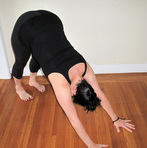|
7/4/2014 The Subtle HeartThe heart chakra, or Anahata, is often mentioned in yoga and we are often asked to open the heart, but what does this actually mean and how can we go about it? The heart chakra is the fourth chakra in the seven chakra system. Is is a mid-point and cross-roads that integrates the worldly experiences of the lower chakras with the more rarefied spiritual experiences of the higher chakras. We can use self-acceptance, love and compassion to release any feelings of doubt or defectiveness that we may have accumulated from old emotional and relationship patterns from our past. Through this integration we are able to open ourselves up to both joy and sorrow so that we are not closed off from any emotion within the heart's realm of experience. The word Anahata translates as "un-struck" which refers to a musical instrument that plays subtle beautiful notes without being touched and to a heart that is un-afflicted by resentment or sorrow. Imagine what it would be like to live as if you had never known disappointment, rejection or hurt? This week it is our goal to bring this openness into our experience through gentle movement which creates physical space in the chest and shoulders; to bring conscious breathing into this area to help to clear stagnant energy which will ultimately help to release old emotional burdens.  Supported Heart Opener Set up two bolsters perpendicular to mat with folded blanket on the one toward the back of the mat. Sit on folded blanket or on floor facing away from bolsters. Lie back so that shoulder blades and upper back are supported by shorted bolster and the head and neck are supported by the taller bolster. The upper line of the shoulders and arms should fall in between the bolsters. If the elbows to not readily reach the floor, support with more folded blankets. Either straighten legs out to floor or rest knees over bolster. Therapeutics: Opens heart and releases tension across chest, shoulders and neck  Garuda Mudra Cross the left wrist in front of the right and interlace the thumbs together, splay the other fingers over the upper chest. Benefits: Balances the right and left sides of the body, creates a sense of freedom Practice Tips: Use when you feel stuck in your life or emotions Contraindications: High blood pressure use caution and monitor  Balasana to Bhujangasana (Child's Pose to Cobra Pose) Begin in Balasana with the arms overhead on the floor. Inhale keep hands where they are and move torso through arms to come into a backbend with pelvis pressing towards floor. Exhale return to Balasana. Repeat 5-10 times with the breath. Therapeutics: Alternately stretches and strengthens front and back of body.  Vajrapradama Mudra Clasp fingers and open palms toward heart; point thumbs upwards. Hold a few inches away from the chest. Benefits: Builds confidence, security, opens the heart very gently Practice Tips: Use when frightened or anxious  Sphinx Lay on belly with legs together and toes pointed back. Bring forearms to floor with elbows aligned under shoulders and forearms parallel to each other, palms facing down. Lift sternum forward and up through crown of head. If lower back feels vulnerable, engage belly away from floor. Hold 5-10 breaths and release chest to floor with hands under forehead. Therapeutics: Stretches front of body, creates space between vertebrae  Adho Mukha Svanasana (Downward Facing Dog) Begin on all fours with hands slightly forward of shoulders. Turn toes under and lift knees off floor. Keep shoulders wide and palms flat, press thighs and sit bones back, scooping belly in. Hold 1-3 minutes, release into Child's Pose. Therapeutics: Strengthens arms and shoulders, stretches back of torso and legs  Virabhadrasana I (Warrior I) Begin standing in Tadasana. Step left leg back about three feet keeping feet hips width apart. Keep right toes turned forward and left foot turned slightly out. Turn hips gently towards front foot and balance weight on both feet. Inhale arms overhead. Exhale and bend right knee. Draw belly up and release tail bone towards floor. Hold 5-10 breaths then release and change sides. Therapeutics: Opens front body and psoas, strengthens legs, improves balance  Supta Balasana (Supported Child's Pose) Kneel straddling a long bolster. Place a second bolster over first with end of bolster in front of your low abdomen. A third bolster can go under the far end of the second bolster or use a folded blanket or block to support under it. Extend front of body over second bolster and rest forehead on backs of hands. Rest up to 5 minutes. Therapeutics: Creates a calm, grounded space to get away from the demands of daily life
3 Comments
10/9/2014 10:19:50 pm
I would like to know details and benefits of the Gupta Mudra. I would also be interested in knowing if I can do a Mudra course and from where can it be done. I am from India. If it is possible to do a certified Mudra course kindly do let me know. Your response will be highly appreciated
Reply
10/10/2014 12:36:56 pm
Deepa,
Reply
Cheryl Brown
10/10/2014 12:37:26 pm
The link for Gupta Mudra is
Reply
Leave a Reply. |
Index:Archives:
September 2022
I attend Cheryl's class regularly and feel that my practice has improved immensely over the past few years due to her expert coaching. Her teaching style is clear and compassionate and her previous experience in teaching adults is evident in her organized approach and easy to understand instructions. I also appreciate that Cheryl not only teaches us about how to correctly position ourselves, but also touches on many aspects of yoga philosophy, which in turn has deepened my personal practice and heightened my awareness of the connection between mind and body, breath and relaxation. |

 RSS Feed
RSS Feed
